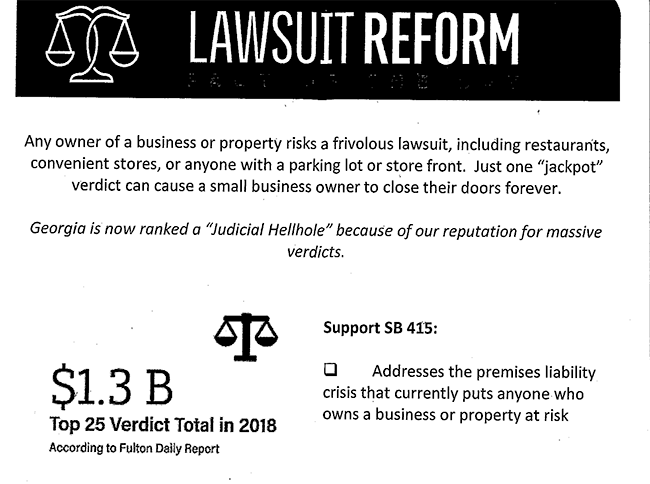The Myth of Full Compensation in Personal Injury Cases
Posted by Wetherington Law Firm | Articles
- Articles
- Artificial Intelligence
- Car Accidents
- Class Action Lawsuit
- Comparative Negligence
- Crime Victim
- Defective Vehicles
- Disability
- Kratom Death and Injury
- Legal Marketing
- Motor Vehicle Accidents
- News/Media
- Other
- Pedestrian Accidents
- Personal Injury
- Results
- Sexual Assault
- Truck Accidents
- Uber
- Wrongful Death
Categories
Most People Never Recover a Fair Amount in Personal Injury Litigation
Here is a dirty secret of the legal industry: despite nearly every attorney in the country (including me) promising “full compensation,” it rarely happens. The civil justice system exists to place injury victims in the same financial position he or she would have been if not for an injury. It is a noble concept, but mostly aspirational due to factors outside any attorney’s control.
It is not a secret that the Chamber of Commerce and its allies spend BILLIONS lobbying for legislation that significantly restricts an injured person’s ability to recover compensation. These efforts result in “tort reform” initiatives. Meanwhile, arbitration clauses and no-class-action agreements embedded into contracts keep injury victims from filing suit at all. Cumulatively, these efforts have taken a heavy toll on the civil justice system, and the amount of money one can expect to recover in a personal injury lawsuit. For many, it means a lifetime of pain and suffering with little to compensate for it.
What Are You Legally Entitled to Recover in a Personal Injury Lawsuit?
The law of torts governs personal injury damages. As previously mentioned, the goal of tort law is to restore the plaintiff to the financial position they were in before the injury occurred. In most states, damages to an injury victim fall into two categories: special damages and general damages.
Special damages are easy to understand. They are the hard numbers that can be quantified. Things like medical bills, funeral bills, and lost wages are considered special damages. These losses have a specific dollar value, with receipts to prove it.
General damages involve intangible losses like pain and suffering, disfigurement, and mental anguish. These damages have no specific dollar value, but they are generally valued MUCH higher than the medical bills. In a straightforward injury case where the person is injured but gets completely better, attorneys typically value the pain and suffering at between three and five times the medical bills, depending on the individual circumstances of the case. Cases involving permanent injury or impairment, intentional misconduct, or grossly negligent behavior frequently justify general damage awards of at least ten times the medical bills. But, this is just a starting point. Considerations like the medical history of the victim, actual pain and suffering, and the long-term impact on a person’s life move this number up and down.
There is a lot that goes into the valuation of general damages. For simplicity, special damages often set the floor for monetary damages in a personal injury suit. But what a case is actually worth rarely matters. The real question is: what portion of these damages, if any, are legally recoverable? There are several factors that put caps on recovery that are out of your attorney’s control and will diminish the final settlement amount.
The Three D’s of Insurance Claims: Deny, Delay, and Defend
While the insurance industry only talks about petty fraud committed by its policyholders, they rarely address the economic realities of their industry. Despite RECORD profits, insurers continue to raise premiums, deny claims, and refuse insurance to those who need it most. Worse, individuals and small businesses that purchase insurance are not getting the protection the insurance company promised, and claimants do not receive the compensation they are ethically and legally entitled to receive.
In naming Allstate “The Worst Insurance Company in America,” the American Association for Justice cited Allstate’s careful efforts to put profits over policyholders. Former Allstate employees call it the “three D’s”: deny, delay, and defend. In training its employees, Allstate uses a Powerpoint featuring an alligator and the caption “sit and wait”—emphasizing that delaying claims will increase the likelihood that the claimant gives up.
Insurance Companies Incentivize Adjusters and Defense Attorneys to Delay Resolution of Your Claim
Take, for example, an insurance claim involving death. It may surprise you to learn that death is generally valued less than a claim involving a lifetime of medical care. Consider this case: a young man is rendered quadriplegic after a serious car accident. He lives in a rural part of Georgia with poor access to medical care. His mother is disabled, and the only living family member able to care for him. His existing medical bills are over $1 million, and he needs several million more to pay for around the clock medical treatment for the rest of his life. The insurance companies have access to all of his medical records and know this fact. Were the individual to die, none of this additional care would be required. As a result, the insurance company will delay the claim as long as possible to see if he dies before a jury resolves the case. This scenario plays itself out every day.
If you are in this mother’s position, what do you do? Your son needs $1 million in medical treatment right now. He is also may be entitled to at least $10 million in compensation for pain and suffering. The state is helping, but it is slow, and the quality of care is low. The family is also in poverty now because they spent all of their life savings buying medical equipment that is not covered by medical insurance. The insurance company is offering $500,000. Would you take the offer? Several families in Georgia are facing this exact question right now. How would you advise them?
Insurance Companies Do Not Play by the Rules
By denying valid claims, delaying settlement of accepted claims, and using “hardball” litigation tactics, insurance companies bully injury victims into accepting well below the “full” value of an insurance claim. In some cases, these tactics result in paying nothing at all.
The Northridge earthquake in California killed 57 people, injured 9,000, and was the costliest earthquake in U.S. history. Insurance companies like State Farm did everything they could to avoid having to pay valid claims to earthquake victims. After the earthquake, a State Farm employee testified that company officials forged signatures on earthquake waivers to avoid paying quake-related claims and then withheld evidence when victims demanded answers. State Farm and other insurers accused of mishandling claims were fined over $3 billion in penalties. However, State Farm never actually paid the fines. Instead, an insurance department whistle-blower would eventually reveal that the insurers donated $12 million to two non-profit foundations created by insurance commissioner Chuck Quackenbush in what was ultimately considered a bribe. Fortunately, State Farm was caught and (marginally) punished for this scam. But many families are fraudulently deprived of insurance settlements every year with little recourse. For small claims involving less than $10,000 it can be almost impossible to find an attorney willing to take on the case where coverage has been denied improperly.
Sometimes There Just Isn’t Enough Insurance Coverage
Sometimes a person has a catastrophic injury, liability is admitted, and the insurance company is willing to pay. Even when this true, there may not be enough money to go around. This most often happens when an at-fault party has no insurance or minimal insurance coverage. For example, a family recently had $1 million in medical bills after a motorcycle wreck in Georgia, but the at-fault party was uninsured and had no assets. The family was lucky to have $50,000 in uninsured motorist coverage for this exact situation. The insurance company, USAA, immediately agreed to pay the full policy limits. Even though ALL of the available money is recovered, it did almost nothing to help the family financially. Every attorney has similar stories and you probably know people with similar experiences in your own life.
But What About Those Large Jury Verdicts?
Most jury verdicts result in monetary payments much lower than the amount awarded by the jury. Google the phrase “nuclear verdict.” You will find websites created by insurance companies claiming that jury verdicts are OUT OF CONTROL and bad for business.
Insurers create lists of verdicts over $100 million and claim that the U.S. economy is under attack. The merits of the cases do not matter. The fact that an impartial group of twelve people, under the guidance of a judge, determined that the amount was appropriate is irrelevant to them. They also ignore the fact that almost every verdict on their lists did not result in a payment for the full verdict amount to the victim.
Here is an example recently pushed in the Georgia legislature. The bill in question would make property owners immune from certain lawsuits and protect corporations who knowingly introduce poisonous products to our children and families. Nonetheless, the supporters of this bill thought it was necessary to keep Georgia from being a “Judicial Hellhole.”

Personal injury lawyers are complicit in this delusion. Go to any law firm website, and there will be a list of large jury verdicts. Some of the verdicts resulted in full payment; most did not. Damage caps, remitter orders, confidential high-low agreements, and lack of coverage reduce or eliminate the verdict amount in many cases.
Damages Caps Can Leave You With Almost Nothing
Damages caps are limits on the amount of money recoverable in a personal injury lawsuit. These are a form of tort reform meant to protect insurance companies from paying claims. Here is what a monetary cap looked like to the parents of two-year-old Steven Olsen in California: Their little boy was injured after he tripped and fell. Steven’s mother took him to the local hospital where he was examined and sent home. His symptoms did not improve, and he returned to the hospital several days later and requested a CAT scan. The doctors refused to authorize the $800 CAT scan. The scan would have detected a growing abscess in his brain. Steven then became blind and severely brain-damaged. His mother had to leave her job to care for him. After assessing the evidence and testimony from other doctors, a jury determined that the failure to order a CAT scan was improper. The jury awarded the child $7.1 million for a lifetime of darkness and pain. The jury was never told what happened next. The judge was forced to reduce the verdict to $250,000 because of a law capping general damages in the state.
Insurers want to bring the same caps back to Georgia. In 2005, the Georgia Legislature passed a cap on noneconomic damages for medical malpractice claims. The Georgia Supreme Court struck the law down as unconstitutional because it violated the right to trial by jury. In 2020, they hope to revive the caps and make them even worse for injury victims. If laws capping damages pass, this would limit damages for defective products to $250,000, make it harder to sue property owners, and bar plaintiff’s lawyers from arguing for “full compensation” at trial.
Remittitur Orders Reduce Jury Verdicts
Remittitur is a procedure where a judge orders the reduction of a verdict. In 2015, a jury in Bainbridge, Georgia, awarded the parents of a child that burned to death $150 million. This child died a long and painful death due to a defective Jeep Grand Cherokee that caught on fire when involved in ordinary wrecks. The case made national headlines and was touted by the auto industry as “arbitrary, irrational, and designed to punish” the automaker. The verdict was eleven times larger than the next closest jury verdict for a wrongful death in Georgia.
The parents in the case voluntarily agreed to an Order reducing the verdict to $40 million. The car manufacturer appealed anyway. More than one year later, the Supreme Court of Georgia upheld the verdict as fair and supported by hard evidence. In the end, the family received less than half the amount awarded by the jury. But the insurance industry never mentions this fact and only talks about the original verdict to scare people.

Confidential High-Low Agreements Reduce Jury Verdicts
A high-low agreement sets the minimum and maximum that will be paid after trial. At their best, high-low agreements help opposing sides reach an agreement they can both live with and avoid any possibility of appeal. For example, presume there is $1 million in insurance coverage available and $100,000 in medical bills. The plaintiff wants to receive the full $1 million. The insurance company wants to pay $300,000. The parties can agree to take the case to trial with a $300,000 – $1 million high-low agreement. Meaning, if the plaintiff loses, he receives $300,000. If the plaintiff receives a verdict of $1 million or more, he receives $1 million. If the verdict falls anywhere between $300,000 and $1 million, the insurer will pay the verdict amount.
The only problem with high-low agreements is that they generally have nothing to do with the actual value of the case and are more of a recognition of the insurance coverage available and desire of the plaintiff to avoid a lengthy appeal.
Lack of Coverage Leads to “Paper Verdicts”
In many cases, a verdict will exceed the available policy limits provided by the insurance company. For example, I recently had a case with $1 million in insurance available. My client was badly injured and his claim was obviously worth more than $1 million. But the insurance company refused to pay. I took the case to trial, and a jury awarded $2.8 million. After the verdict, my client did not receive the $2.8 million the jury determined he was entitled to receive. Instead, it resolved for a confidential amount. In some instances, an insurance company can be on the hook for the full verdict when the insurance company gambles with their insured’s money and lose. But, the insurance companies have taken steps to make this even harder.
In other cases, the entire verdict can go away. Several years ago, I took a case to trial for a police officer seriously injured in a car accident. Her medical bills exceeded $1 million. The insurance company denied her claim for $25,000 in insurance benefits. After years of fighting, a judge ultimately issued an order awarding $10 million. The case was significant because the insurance company itself agreed that the amount was reasonable. Despite this fact, the insurance company claimed that it was not on the hook for paying the award and filed something called a declaratory action. In the declaratory action, the insurance company claimed that, although they declined an opportunity to settle the case for $25,000, they should not be on the hook for the “full value” of the case. And a federal judge agreed. Here, it is important to note that the wreck occurred in 2012, the damages award was issued in 2015, the award was nullified in 2019, and the case is still on appeal today. Seeing a pattern here? Sit and Wait.
Conclusion
Injury victims and their families are unwillingly thrust into a legal system that they are unprepared for and where the odds are dramatically stacked against them. It is important that attorneys fully disclose the financial landscape of civil justice and compensatory damages. Find a lawyer that is competent, honest, and has a plan for achieving justice within the confines of what is financially and legally possible.
